Related Research Articles

Pandit Birju Maharaj was an Indian dancer, composer, singer and exponent of the Lucknow "Kalka-Bindadin" Gharana of Kathak dance in India. He was a descendant of the Maharaj family of Kathak dancers, which includes his two uncles, Shambhu Maharaj and Lachhu Maharaj, and his father and guru, Acchan Maharaj. He also practised Hindustani classical music and was a vocalist. After working along with his uncle, Shambhu Maharaj at Bhartiya Kala Kendra, later the Kathak Kendra, New Delhi, he remained head of the latter, for several years, until his retirement in 1998 when he opened his own dance school, Kalashram, also in Delhi.

Kuchipudi ( Telugu: te:కూచిపూడి నృత్యం) is one of the eight major Indian classical dances. It originates from a village named Kuchipudi in the Indian state of Andhra Pradesh.

Mulk Raj Anand was an Indian writer in English, recognised for his depiction of the lives of the poorer castes in traditional Indian society. One of the pioneers of Indo-Anglian fiction, he, together with R. K. Narayan, Ahmad Ali and Raja Rao, was one of the first India-based writers in English to gain an International readership. Anand is admired for his novels and short stories, which have acquired the status of classics of modern Indian English literature; they are noted for their perceptive insight into the lives of the oppressed and for their analysis of impoverishment, exploitation and misfortune. He became known for his protest novel Untouchable (1935), followed by other works on the Indian poor such as Coolie (1936) and Two Leaves and a Bud (1937). He is also noted for being among the first writers to incorporate Punjabi and Hindustani idioms into English, and was a recipient of the civilian honour of the Padma Bhushan.

Kathak is one of the eight major forms of Indian classical dance and one of the many Pakistani art forms. It is the classical dance form of Uttar Pradesh. The origin of Kathak is traditionally attributed to the traveling bards in the of ancient northern India and Pakistan known as Kathakars or storytellers. The term Kathak is derived from the Vedic Sanskrit word Katha which means "story", and Kathakar which means "the one who tells a story", or "to do with stories". Wandering Kathakars communicated stories from the great epics and ancient mythology through dance, songs and music. Kathak dancers tell various stories through their hand movements and extensive footwork, their body movements and flexibility but most importantly through their facial expressions. Kathak evolved during the Bhakti movement, particularly by incorporating the childhood and stories of the Hindu god Krishna, as well as independently in the courts of north Indian kingdoms. During the period of Mughal rule, the emperors were patrons Kathak dance and actively promoted it in their royal court. Kathak performances include Urdu Ghazals and commonly used instruments brought during the Mughal period. As a result, it is the only Indian classical dance form to feature Persian elements.
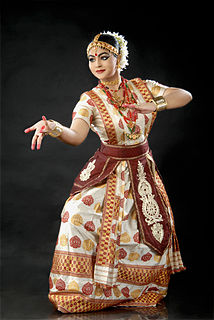
Sattriya, or Sattriya Nritya, is a major Indian classical dance. It is a dance-drama performance art with origins in the Krishna-centered Vaishnavism monasteries of Assam, and attributed to the 15th century Bhakti movement scholar and saint Mahapurush Srimanta Sankardev.

Indian classical dance or Shastriya Devesh is an umbrella term for various performance arts rooted in Hindu musical theatre styles, whose theory and practice can be traced to the Sanskrit text Natya Shastra. The number of classical dances range from eight to more, depending on the source and scholar. The Sangeet Natak Academy recognizes eight – Bharatanatyam, Kathak, Kuchipudi, Odissi, Kathakali, Sattriya, Manipuri and Mohiniyattam. Scholars such as Drid Williams add Chhau, Yakshagana and Bhagavata Mela to the list. Additionally, the Indian Ministry of Culture includes Chhau in its classical list. These dances are traditionally regional. They consist of compositions in Hindi, Malayalam, Meitei (Manipuri), Sanskrit, Tamil, Telugu, or any other Indian language and they represent a unity of core ideas in a diversity of styles, costumes and expression. Currently, there are 9 official classical dances in India.

Sitara Devi was an Indian dancer of the classical Kathak style of dancing, a singer, and an actress. She was the recipient of several awards and accolades, and performed at several prestigious venues in India and abroad; including the Royal Albert Hall, London (1967) and at the Carnegie Hall, New York (1976).
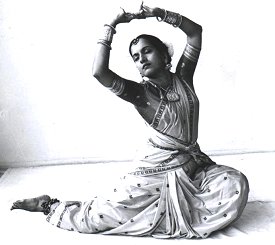
Damayanti Joshi was a noted renowned exponent of the Kathak dance form.She believed Kathak is the art of storytelling. She began in the 1930s dancing in Madame Menaka's troupe, which travelled to many parts of the world. She learnt Kathak from Sitaram Prasad of Jaipur Gharana and became an adept dancer at a very young age, and later trained under from Acchan Maharaj, Lacchu Maharaj and Shambhu Maharaj of Lucknow gharana, thus imbibing nuances from both the traditions. She became independent in the 1950s and achieved prominence in the 1960s, before turning into a guru at her dance school in Mumbai.
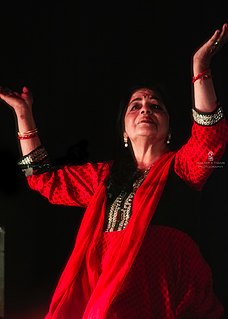
Uma Sharma is a kathak dancer, choreographer and teacher. She is also runs the Bharatiya Sangeet Sadan, Delhi, a classical dance and music academy, situated in New Delhi, founded by her father in 1946. She is most known for reviving the old classical dance form of Natwari Nritya or the Raslila of Brindavan, which later evolved into the Kathak.
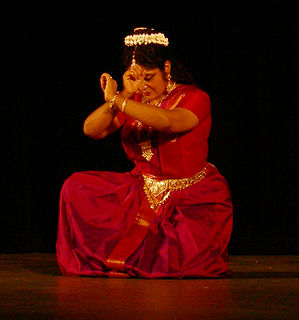
Chitra Visweswaran is an Indian Bharata Natyam dancer who runs a dance school, the Chidambaram Academy of Performing Arts, in Chennai.

Sunil Kothari was a noted Indian dance historian, scholar and critic. He was also former Uday Shankar Professor at Ravindra Bharti University, Kolkata.
National Institute of Kathak Dance, also known as Kathak Kendra, is the premier dance institution for the Indian classical dance form of Kathak, and a unit of the Sangeet Natak Akademi, India's National Academy of Music, Dance and Drama, situated in New Delhi. Established in 1964, the institution is primarily dedicated to Kathak, though it also offers courses in Hindustani classical music (Vocal) and Pakhawaj and Tabla.

Gopi Krishna was an Indian dancer, actor and choreographer.
Rohini Bhate was among the senior most Kathak dance exponents in India, who developed as a performer, teacher, writer, researcher and critic this Indian classical dance. During her career, she was awarded with several recognitions, such as the Sangeet Natak Akademi Award, and the Kalidas Samman.
Shanta Rao was a notable dancer from India. She studied and performed Kathakali, Bharatanatyam and Kuchipudi.
Roshan Kumari Fakir Mohammad is an Indian classical dancer, actor and choreographer, considered by many as one of the foremost exponents of the Indian classical dance form of Kathak. She follows the Jaipur Gharana and is the founder of Nritya Kala Kendra, Mumbai, an academy promoting Kathak. A recipient of the Sangeet Natak Akademi Award in 1975, she received the fourth highest Indian civilian honour of Padma Shri from the Government of India in 1984.
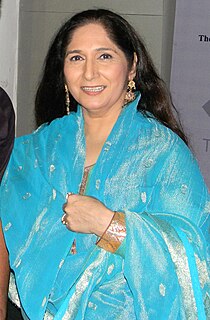
Uma Dogra is an Indian exponent of Kathak, an Indian Classical Dance form. She is the senior most disciple of Pt. Durga Lal, the Kathak Maestro from Jaipur Gharana. She is a Kathak soloist, a choreographer and a teacher. She has been performing in India and abroad for more than 40 years.
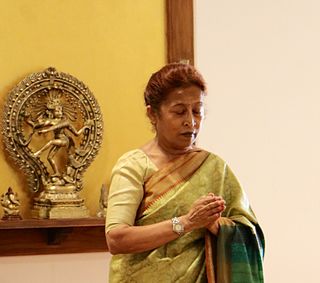
Guru Shama Bhate (born 6 October 1950) also known as Shama Tai, is among the Kathak exponents in India today. Her career spans over 40 years and she has been learning and performing Kathak from the age of 4 and has been a teacher and is involved with choreography and training many Kathak dancers in India. She is also the artistic director of her Dance Academy Nadroop in Pune

Puru Dadheech is a Kathak dancer. He is a choreographer and educator of Indian classical dance, and is known for his pioneering work in the field of Kathak. At the oldest Kathak department which was formed in 1956 at Indira Kala Sangeet Vishwavidyalaya Public University located in Khairagarh, Puru Dadheech instated the first Kathak syllabus in 1961. He is the holder of the first Doctorate in Kathak Classical Dance and emphasizes the relevance of Shastras in the Kathak repertoire. He was awarded Padma Shri, the 4th highest civilian award of India He is currently serving as the Director of the world’s first dedicated Kathak research Centre at the Sri Sri University, Cuttack called Sri Sri Centre for Advanced Research in Kathak.
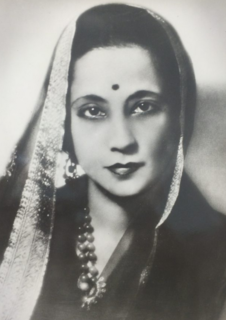
Madame Menaka was the professional name of Leila Roy, Lady Sokhey, an Indian dancer and choreographer in the Kathak tradition.
References
- 1 2 3 4 5 6 7 Kothari, Sunil (3 October 2017). "Remembering Shirin Vajifdar – Pioneer in All Schools of Dance". The Wire. Retrieved 4 October 2017.
- ↑ Singh, Nancy (1986). The Sugar in the Milk: the Parsis in India. Madras: Institute for Development Education. p. 39.
- 1 2 Kothari, Sunil (1989). Kathak, Indian Classical Dance Art. Abhinav Publications. p. 182. ISBN 978-81-7017-223-9.
- ↑ Rutherford, Anna (1979). "Anand, Mulk Raj" (PDF). Commonwealth Literature. p. 20. ISBN 978-1-349-86101-9 . Retrieved 4 October 2017.
- 1 2 Bharatan, Raju (1 August 2016). Asha Bhosle: A Musical Biography. Hay House, Inc. p. 283. ISBN 978-93-85827-16-7.
- ↑ Basu, Soma (19 July 2012). "Arc lights to oblivion". The Hindu. Retrieved 4 October 2017.
- ↑ Haskell, Arnold Lionel (1960). The Ballet Annual. A. & C. Black. p. 111.
- ↑ Parsiana. Vol. 22. P. Warden. 1999. p. 158.
- ↑ Singha, Rina; Massey, Reginald (1967). Indian dances: their history and growth. Faber. p. 223. ISBN 9780807604274.
- ↑ Doctor, Vikram (9 August 2017). "Food for thought: India can take some feasting lessons from Italy". The Economic Times . Retrieved 4 October 2017.
- ↑ "Dancers Due in S'pore". The Straits Times. 19 January 1951. Retrieved 4 October 2017.
- ↑ "Shirin Vajifdar and Krishna Kutty in their New Indian Ballet". The Radio Times (1505): 45. 19 September 1952. Retrieved 4 October 2017.
- ↑ The Indian Cultural Delegation in China, 1955. Foreign Languages Press. 1955. p. 60.
- ↑ Chinese Literature. Foreign Languages Press. 1956. pp. 162–163.